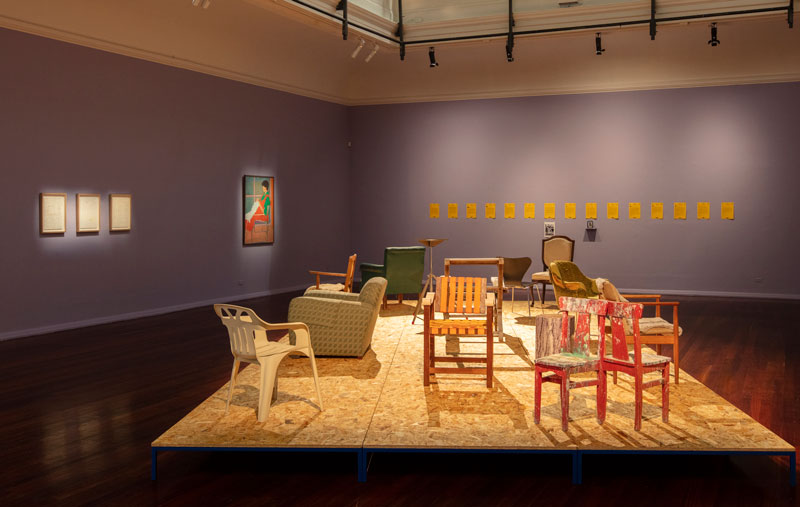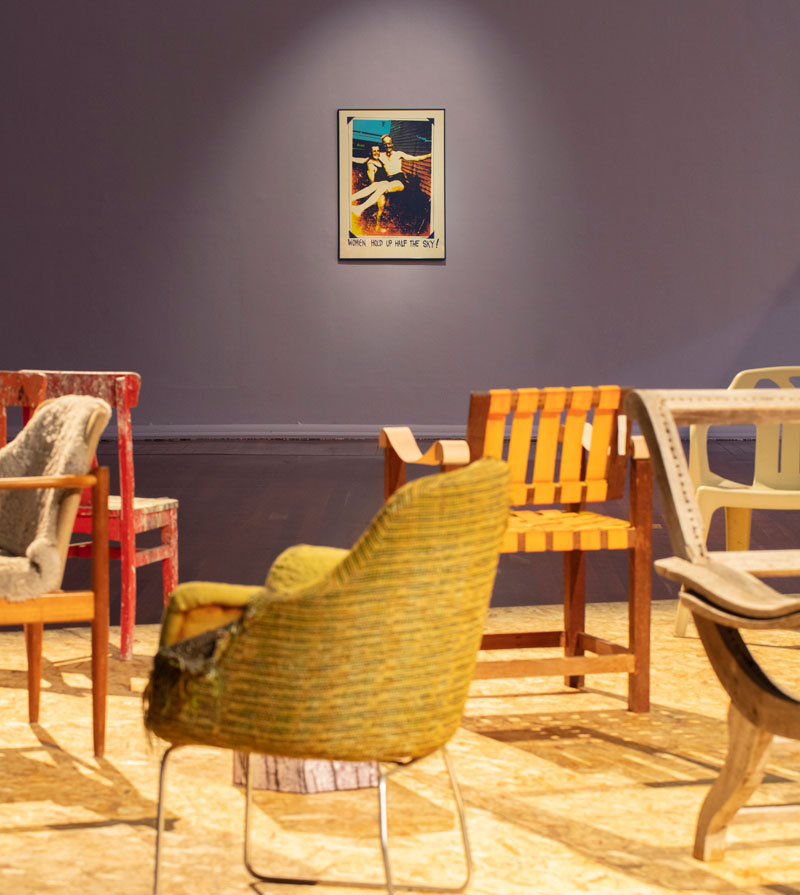
Trying to Find Comfort in an Uncomfortable Chair is the title of Agatha Gothe-Snape’s latest exhibition at the Perth Institute of Contemporary Arts. In its simplest form this exhibition is Gothe-Snape’s response to the Cruther’s Collection of Women’s Art (CCWA) of which her work is also a part. But what can you say when the hand that feeds you asks you for your opinion in return? There is a complex and productive tension that underpins this show. Through Trying to Find Comfort in an Uncomfortable Chair Gothe-Snape crafts a lyrical, personal and deeply critical engagement with the CCWA by surfacing the often-contradictory feelings of being collected, of being categorised, and of being a woman (artist).
Sir James and Lady Sheila Cruthers began collecting art in the mid-1970s and their collection, gifted to the University of Western Australia in 2007, is now the only public collection in Australia focused specifically on women’s art. In the context of an (art) world still defined by unequal representation, this is not only necessary, but even radical. To collect only “women’s art” is not an apolitical act; it corresponds with the key question asked in Linda Nochlin’s seminal 1971 essay, “Why are there no great women artists?”. Just as apparent today, the dismal statistical landscape of art in Australia has surfaced through The CoUNTess Report of 2014: while women are 74% of art school graduates they are only 34% of artists exhibited in our state museums and galleries, highlighting that for every one male artist three female artists receive the equivalent professional space. Recent affirmative actions across the arts in Australia include the National Gallery of Australia’s #knowmyname campaign, the Sheila Foundation, Melbourne’s Finkelstein Gallery, and awards like the Ravenswood Australian Women’s Art Prize, The Katthy Cavaliere Fellowship and the more well-established Portia Geach Memorial Award. Gothe-Snape’s conceptual activation of the CCWA does not necessarily find comfort within this milieu.
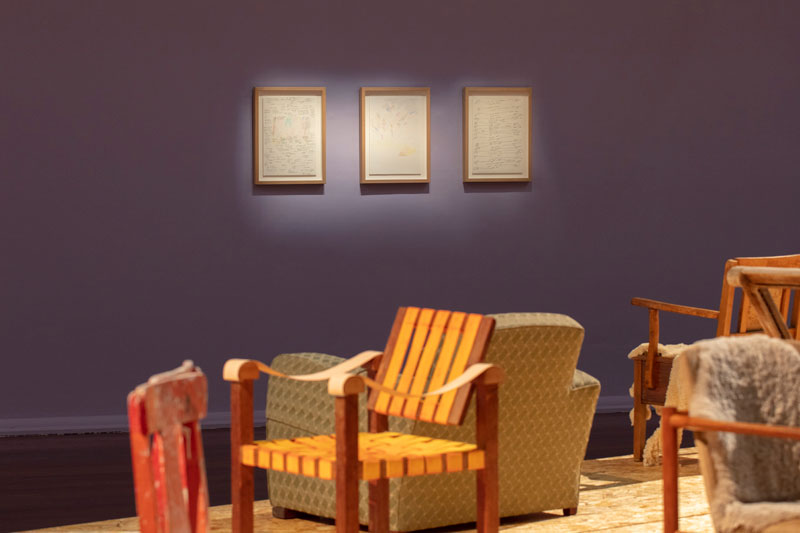
The CCWA has a broad focus on portraiture and self-portraiture, still life, abstraction, postmodernism and second-wave feminism. In contrast and in conversation with these more conventional genres Gothe-Snape has shaped this exhibition around clusters of (always capitalised) CURTAINS, FLOWERS, HOLES and CHAIRS. In her catalogue essay, Gemma Weston, curator of CCWA, has described the exhibition as a dream the collection “itself might have”. Like a dream, the clusters of this exhibition left me with a series of sensations: waves of suffocation and a yearning to escape; awe and solidarity, a sense of comfort and release. These CURTAINS, FLOWERS, HOLES and CHAIRS tug at the seemingly inescapable bind presented by gender and genre. They provide new ways of thinking about this collection, and by extension women’s art. They are steps towards a new kind of pedagogy.
Trying to Find Comfort in an Uncomfortable Chair consists of old and new works by Gothe-Snape that have been brought into dialogue with a selection of work by other artists in the CCWA. The exhibition is clearly driven by the belief that art is not an object, but the encounters that take place between artists, objects and the viewing public. Here Gothe-Snape’s spirit of collaboration (described by Weston as a “discipline of generosity”) extends as much to other artists she has invited into the show as to the viewers who are prompted to piece the exhibition together, drawing on the connections that drive the exhibition encounter.
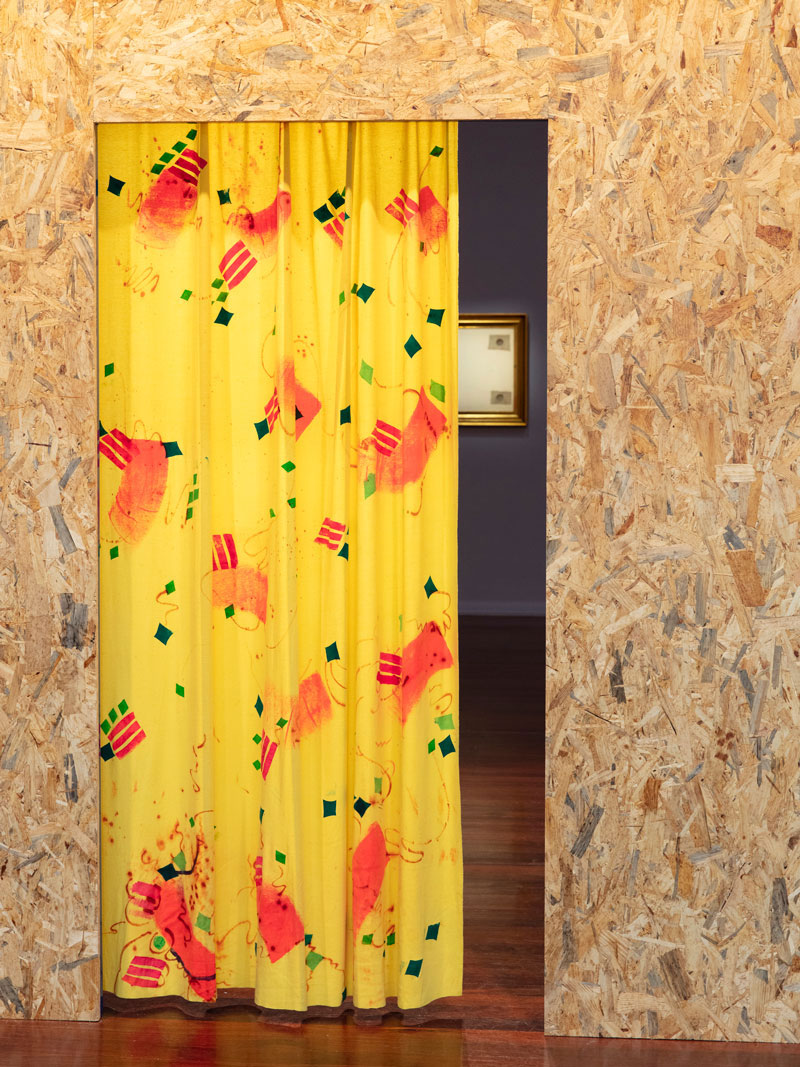
Certain Situations/EXPRESSION CURTAIN (Gothe-Snape, 2013) opens the exhibition by presenting the public with the option to enter the space by passing through a yellow curtain framed by a wall of sterling board—literally fragments of wood that are visibly smashed and squeezed together under a smooth surface. The materiality of this work hints at the uncertainty and violence behind the veneer that characterises many of the social pressures placed on female life. On entry, this is followed by Ann Newmarch’s Women Hold Up Half the Sky (1978), the screen print of an archival image of a woman named Peggy (the artist’s aunt), smiling proudly and carrying a man one assumes to be her husband. A gallery attendant informed me that Peggy was a mother of eight who held down two jobs and built the house she stands in front of in the 1940s. This cluster of CURTAINS is an evocation of domesticity and feminism from various eras—the 1940s, the 1970s, the 1980s. Here, the various uptakes of first, second and third-wave feminisms invoke awe and solidarity but also further questions.
Necessitating a bit more detective work is Gothe-Snape’s Exit Strategies (2018–19). A reproduction of an archival photo of Lake Monger (c. 1914) hangs alone on a wall not far from an empty frame that previously held the German émigré artist Elise Blumann’s 1937 self-portrait, which is concurrently on display in another frame as part of The Artist and Her Work at the Lawrence Wilson Art Gallery. One of the CCWA’s earliest acquisitions, Lady Sheila Cruthers often described Blumann’s work as the foundation for her decades-long interest in women’s self-portraiture. On acquisition Blumann had suggested to the Cruthers that the landscape depicted in the portrait was Lake Monger (Galup), a popular site of settler leisure activities not far from the then family home of the Cruthers in Perth. Later research has identified that the work was actually produced in Europe before Blumann reached Australia. The lone archival photograph comes to possess a more repressed, violent quality, as we learn through a wall text that Lake Monger (Galup) was also the site of a massacre of Noongar people in the late 1800s. Framed by absence, obfuscation and erasure, Exit Strategies is a lateral gesture towards this complex web of erasure and dislocation, migration, colonial ambivalence and survival.
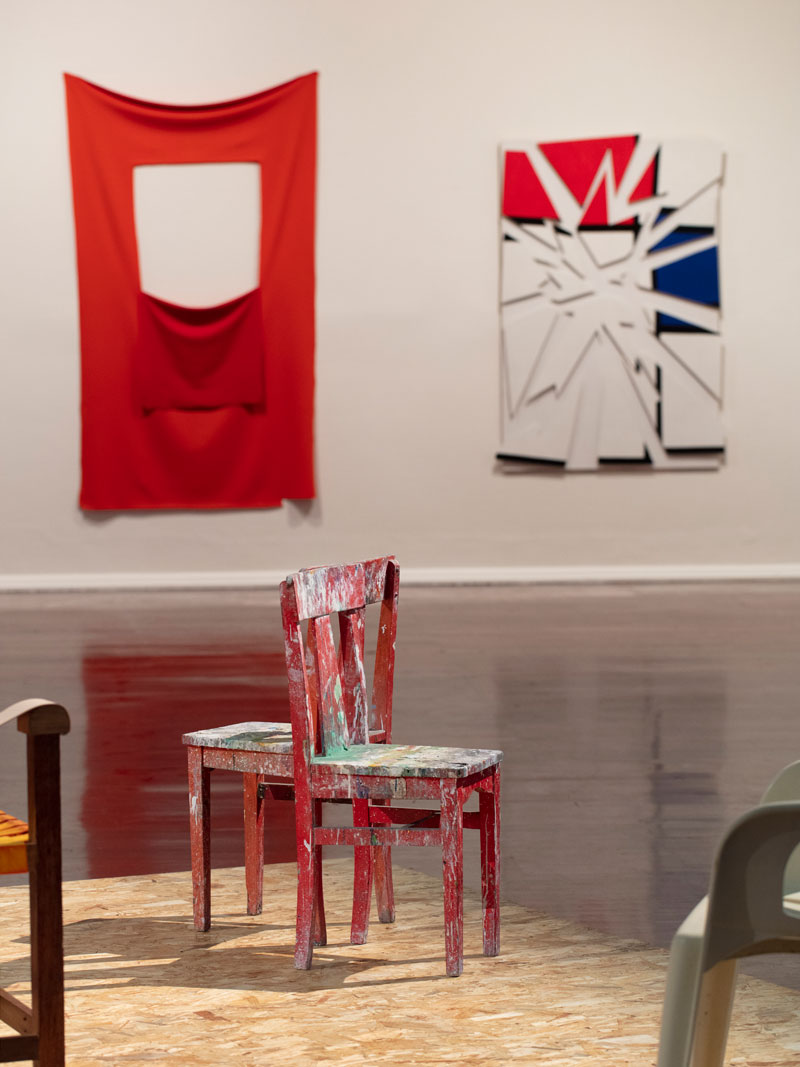
It is no accident that Exit Strategies frames entry to a cluster of HOLES, many of which break apart the canonical gestures of Western modernism. Master Pieces (Mondrian) by Maria Kozic appropriates Mondrian’s work in a defiant gesture. Channeling North American minimalism and Lucy Lippard’s take on soft sculpture and eccentric abstraction, Elizabeth Newman’s 2005 work of cut and suspended red bounded wool hangs with an affecting quality, like a gradually ageing body. Newman took a nine-year hiatus from making art to study psychoanalysis, a practice she now pursues alongside her art. In this light, Lacanian and feminist readings of the HOLE as a lack, a gap, a void co-exist with what I feel is Gothe-Snape’s curatorial intention to employ the HOLE as a means of escape from the category of “women’s art”, the labour of women’s domestic work and a refusal of the limitations of art history. Here the HOLE becomes a path, a door, a window—even an explosion, or an explosive idea—through which we can imagine alternative trajectories.
In a similarly positive affirmation of the HOLE, these markers of absence, defiance and escape at once contrast and correspond with Lily Napanangka and Peter Talbot Jupurrula’s collaborative Ngalikirdi Tjukurpa (Witchetty Grub Dreaming). Measuring almost three metres in length, this is the largest single work in this exhibition, and the only work included by an Indigenous artist and produced collaboratively with a male counterpart. It depicts the connection between a women’s story (Wichetty Grub Dreaming) and a men’s story (Snake Dreaming) related to Country surrounding Coniston. The action of digging into the ground in search for sustenance literally forges a very different kind of materiality as a penetrable HOLE. And in this work the HOLES are also “dots”, aesthetic tools conveying a place, a history, an ecology, a philosophy, both defying and also participating in this colonial economy. The placement of Ngalikirdi Tjukurpa in this exhibition is a bold statement. The work does not feel weighted by gender difference; rather, it is positively defined by it. Ngalikirdi Tjukurpa also usefully draws out Gothe-Snape’s investment in learning as unlearning through intersectionality to disrupt the narrative, and this space of (self) representation.
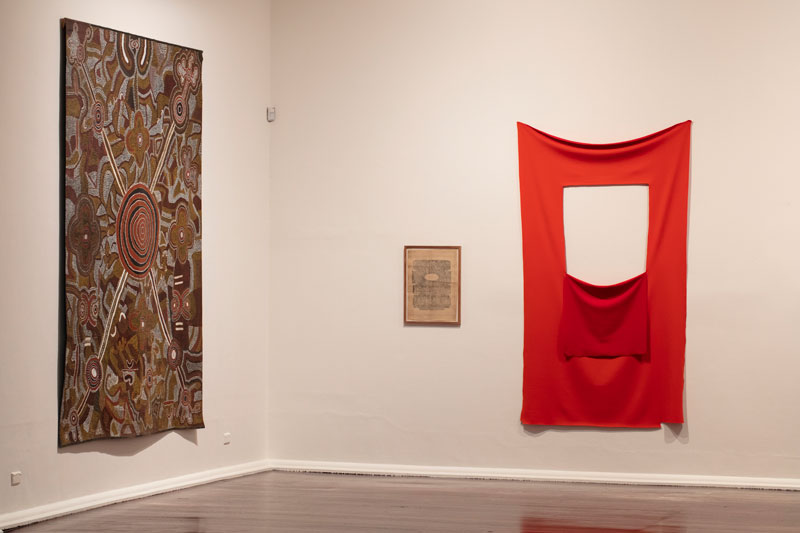
“We must risk unlearning” is a phrase that appears crucial to the exhibition. It stems from the title of a 1975 print by Ann Newmarch acquired by the CCWA. Just as formalist interventions into the historical canon break up art history this print illustrates how “naturalised” attitudes towards women’s bodies should also be seen as violent inventions. Newmarch’s work resonates with the kind of visual language employed by contemporary social media sensation Celeste Barber, whose own restaging of images of celebrity women is an exercise in unlearning attitudes towards women’s bodies. We Must Risk Unlearning is also the title of a PowerPoint animation produced by Gothe-Snape specifically for Trying to Find Comfort in an Uncomfortable Chair. This piece was one of her earliest responses to the CCWA and provides the conceptual and pedagogical rope that binds this disparate selection of works together. This simple yet revealing collation of titles of works from the CCWA presented in syncopated rhythm and juxtaposition, employing a simple black font on a white ground, reads (as an example):
Mixed bunch
The Flower
Red Blossom
Christmas Dinner
Standing Nude
What I must bear
The placement of these, and many other titles on screen and within Gothe-Snape’s conceptual cluster of FLOWERS, is broadly inclusive and gestures to the plurality of tensions at the heart of such a collection of works and the exhibition’s own premise. Within the PowerPoint animation these displaced titles are also somewhat wearing as a cliche of “women’s art”. It is perhaps all the more unsettling that the women artists came up with these titles themselves.
It is at this point in viewing the exhibition that the cluster of CHAIRS plays a supportive and ameliorative role. Underscoring the narrative are a series of generously crafted letters printed on yellow A4 paper against a complementary soft purple wall. In these letters, Gothe-Snape asks a range of people, most of them artists connected to the CCWA, for the loan of a chair. She defines chair, in the broadest sense of the term, as an idea or object that provides emotional, physical and conceptual support. In a letter to the artist Angela Brennan, Gothe-Snape explains that the chairs are a means of reinstating their owner’s bodily presence. The many chairs on display are appropriately worn, weathered, and womanly. One can feel the artists’ palpable presence in their physical absence.
Here I found respite, and a renewed sense of solidarity with the works and their creators. These CHAIRS are accompanied by the painting Waiting for Harry by Giles Hohnen, which depicts his partner, the artist Eveline Kotai, sitting while obviously pregnant with their son Harry. I also detect here a reference to Gothe-Snape’s own conflicted experience of being an artist, a mother and the subject of the Archibald-winning portrait painted by her partner Mitch Cairns. In all of these deliberations, Gothe-Snape persists with navigating this discomfort because frankly there is little alternative. By bringing the idea of the chair to the fore as the embodiment of the absent presence of the artist in a collection, Gothe-Snape conveys the exhaustion, labour and enduring solidarity of all the participants involved.
